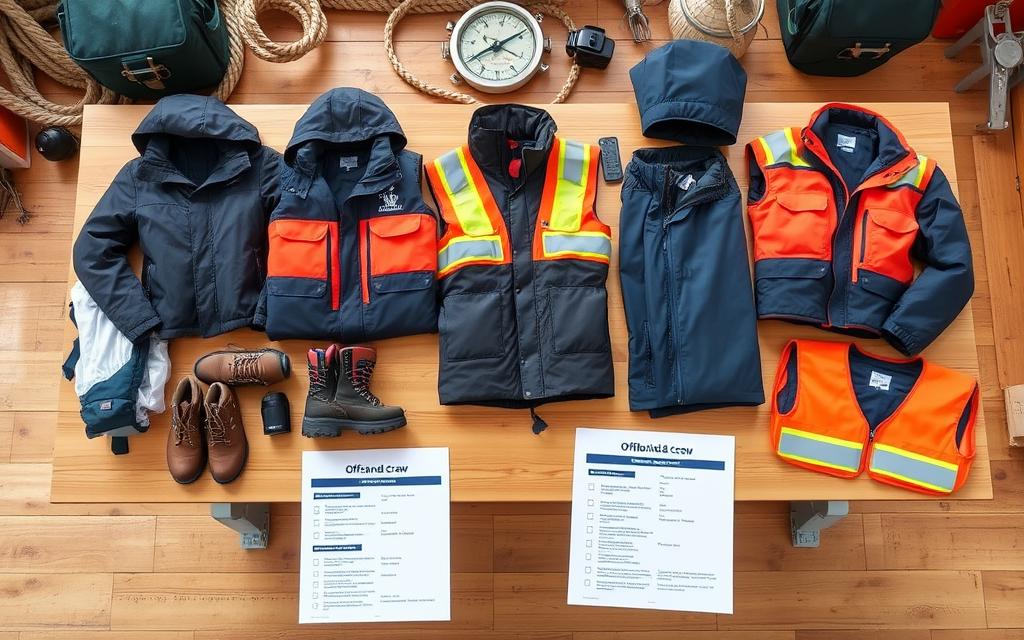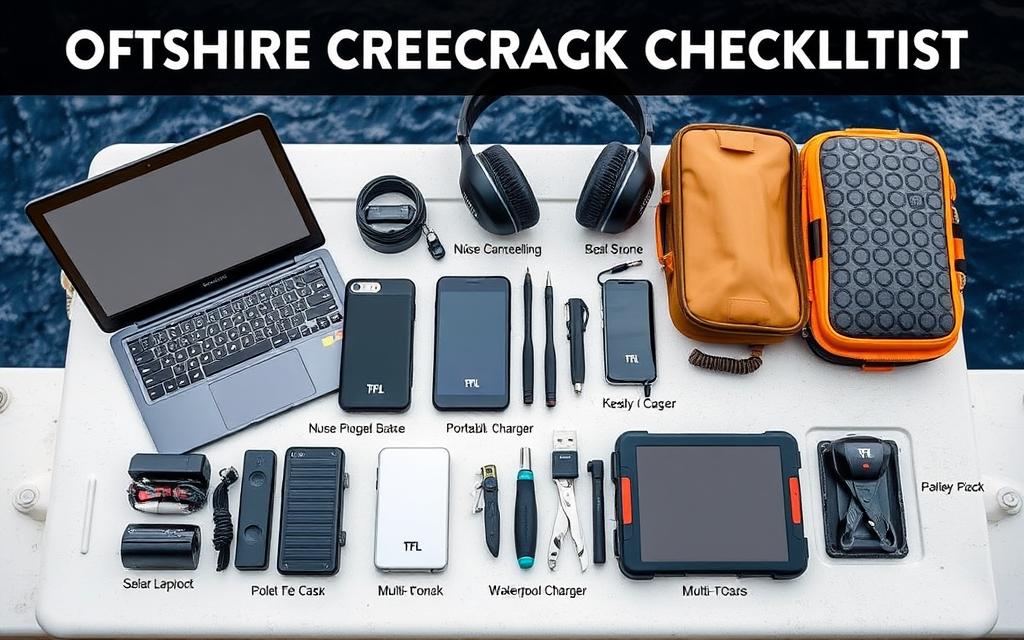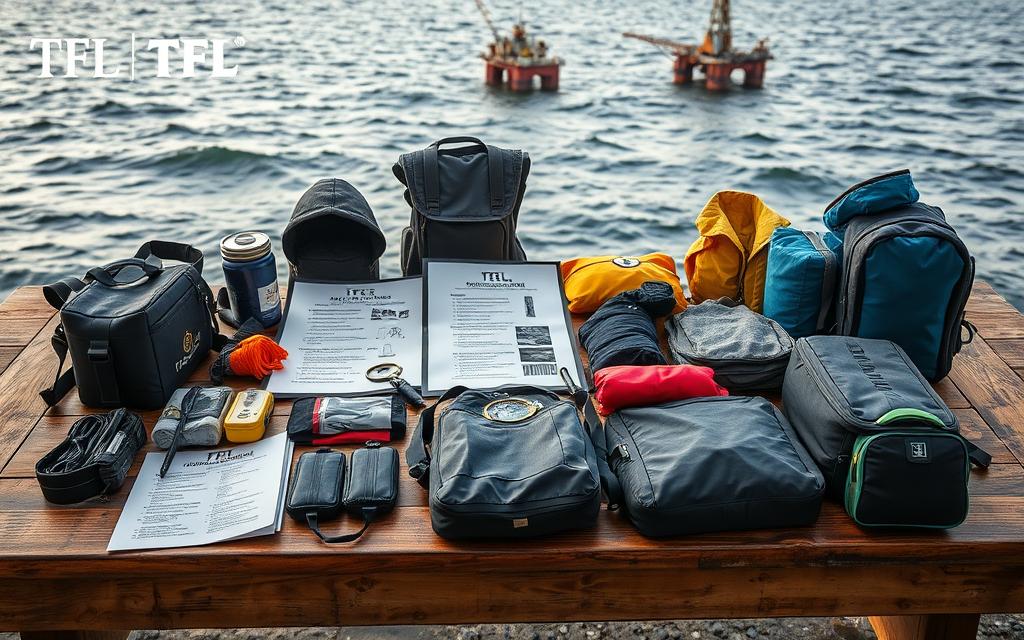Are you heading offshore for work? You’ll need a solid crew packing list. This list will keep you safe, comfortable, and ready for anything.
Packing for offshore work is a balancing act. You have limited space – usually two bags, each weighing 25-35 lbs. One is for clothes and toiletries, the other for work gear and electronics. It’s important to pack smart and light.
Your offshore crew checklist should cover everything. Gear takes up about 30% of your packing list. Toiletries account for 20%. Don’t forget your paperwork (10%) and electronics (15%). Safety gear is a must – it makes up 20% of a typical checklist.
Every crew member needs certain items. These include a water bottle, PFD, AUX cable, sailing watch, earplugs, towel, and a 12V DC to USB charger. Pack smart, stay safe, and you’ll be ready for your offshore adventure!
Essential Personal Protective Equipment (PPE) for Offshore Crews
For offshore workers, packing the right gear is key. A good offshore crew luggage checklist should focus on safety first. Research shows that 95% of crew members bring their personal protective equipment for offshore jobs.
Safety Helmets and Hearing Protection
Hard hats with removable hearing protection are essential. They protect against falling objects and loud noises. Make sure to bring your own for a good fit and to be ready for emergency drills.
Steel-Toed Boots and Impact Gloves
Steel-toed boots protect against heavy objects and keep you steady on slippery surfaces. Impact gloves protect your hands from crushing injuries and vibrations. Don’t forget to include these in your packing list.
Coveralls and Safety Glasses
Bring at least two sets of coveralls to stay clean and look professional. Safety glasses protect your eyes from debris and chemicals. Remember, your PPE is your last defense in dangerous situations.
| PPE Item | Quantity | Purpose |
|---|---|---|
| Hard Hat | 1 | Head protection |
| Steel-Toed Boots | 1 pair | Foot protection |
| Coveralls | 2 sets | Body protection |
| Safety Glasses | 1-2 pairs | Eye protection |
| Impact Gloves | 1-2 pairs | Hand protection |
With over 200 PPE service stations and 660 technicians globally, the offshore industry values safety highly. Always confirm with your crew about the PPE available on board to make sure you’re fully ready for your offshore job.
Clothing Considerations for Offshore Work
Packing the right clothes is key for offshore crew comfort and safety. This guide focuses on must-have items for various conditions.
Climate-Appropriate Attire
It’s crucial to pack clothes right for the environment when working offshore. For warm places like the Gulf of Mexico, go for lightweight, loose clothes. Bring 4-5 t-shirts, athletic pants or shorts, and undergarments. And, remember a light jacket for air-conditioned spaces.
Layering Strategies for Comfort
Layering helps you adjust to changing conditions offshore. Choose clothes you can layer, like:
- Moisture-wicking base layers
- Insulating mid-layers
- Waterproof outer layers
Offshore winds can make it feel 20 degrees colder, so pack right.
Laundry Services and Clothing Care
Most offshore places have fast, free laundry. This means you can pack light, usually needing 3-4 work outfits for a standard rotation. Here are tips for caring for your clothes offshore:
- Choose quick-drying fabrics
- Bring a small laundry bag
- Think about travel-sized detergent

| Clothing Item | Recommended Quantity | Notes |
|---|---|---|
| T-shirts/Workout Tops | 4 | Moisture-wicking fabric preferred |
| Work Pants/Shorts | 3-4 | Durable, comfortable material |
| Undergarments | 5-7 | Boxer briefs recommended for comfort |
| Socks | 5-7 pairs | Good quality for foot comfort |
| Light Jacket/Hoodie | 1 | For air-conditioned areas |
Follow these tips to be ready for your offshore job and keep your luggage light.
Toiletries and Personal Care Items
Packing the right toiletries is key for comfort at sea. Make sure your offshore crew packing list includes essential items for hygiene and well-being. These items help keep you feeling fresh during long sea trips.
- Toothbrush, toothpaste, and floss
- Shampoo, conditioner, and body wash
- Deodorant and moisturizer
- Razor and shaving cream
- Nail clippers and file
- Sunscreen and lip balm
Also, pack any needed medications and feminine hygiene products. About 70% of sailors suggest bringing basic toiletries. But, offshore rigs might not have much. So, it’s smart to bring your own for comfort.
Use travel-sized containers to save space. Packing cubes are also a good idea, as 90% of sailors find them useful. For shower time, bring flip-flops. They’re preferred by 85% of sailors over bulky shoes.
Before you pack, ask your employer about any rules on personal care items. Some places have rules about sealed containers or aerosols. Following these tips will make your stay on the rig more comfortable and clean.
Electronic Devices and Work-Related Gear
When packing for offshore work, make sure to include essential electronic devices and work gear. These items help you stay productive and connected while at sea.
Laptops, Chargers, and Adapters
Don’t forget your company laptop, charger, and a power converter. Offshore rigs use different outlets, so a universal adapter is key. Also, bring a USB storage stick for easy file transfers and backups.
Communication Devices and Accessories
Remember your cell phone and charger. Noise-canceling headphones are great for clear communication in loud places. Always check with your local heliport about electronic device rules, as they can vary.

Data Storage and Backup Solutions
Think about bringing an external hard drive (1-2 terabytes) for entertainment during downtime. It can also be a backup for important work files, since internet may be limited offshore.
| Item | Purpose | Notes |
|---|---|---|
| Laptop | Work tasks | Company-issued preferred |
| Power Converter | Compatibility | Universal adapter recommended |
| USB Drive | File transfer | Minimum 32GB capacity |
| Cell Phone | Communication | Check helicopter restrictions |
| External Hard Drive | Entertainment/Backup | 1-2TB capacity suggested |
Remember, lighters and matches are not allowed offshore. Always double-check your offshore crew checklist to make sure you have all the necessary electronic devices and work gear packed securely.
Offshore Personal Crew Packing Checklist
Creating a detailed crew packing list for offshore work is key for safety and comfort. It should include protective gear, clothing, and personal items. Let’s go over the main items you should pack.
First, focus on safety gear. Make sure to pack a Personal Flotation Device (PFD) with a harness, whistle, and strobe light. Also, a personal locator beacon like the OceanSignal PLB1 is essential. For your feet, choose the Zhik ZK Seaboot for both comfort and safety.
Next, think about your clothing. Layer up with merino wool underwear and socks. Use base layers from brands like Bamboo or Icebreaker. Stay away from cotton as it takes too long to dry. Bring a warm synthetic sleeping bag and a Polartec beanie for cold nights.
- 5 pairs of merino wool underwear
- Waterproof socks
- Fleece mid-layers
- Waterproof outer layers
Personal care items should also be on your list, making up about 26% of your packing. Include sun cream with SPF 50+ and any needed medications. Keep your toiletries in a 5L or 10L dry bag to stay organized and dry.
Lastly, pack essential tools. A Gerber EZ Knife with a blunt nose, tied to your life jacket, is vital. Bring a multi-tool like the Leatherman Wave and a head torch with a red lens for night use. Protect your phone in an Otterbox case.
Your offshore packing list should fit in a 70-90 liter bag. Aim to pack lightly to improve crew performance and boat efficiency. Double-check all necessary paperwork and insurance before you leave. With this detailed crew packing list for offshore work, you’ll be ready for your sea adventure.
Medication and Health Essentials
Getting ready for offshore work means focusing on health first. Make sure to pack medical essentials for your crew. This way, you’re ready for health issues or emergencies at sea.
Prescription Medications and Documentation
Always pack enough prescription meds for your whole trip. Keep them in their original bottles with clear labels. Also, carry copies of your prescriptions and doctor’s notes. This is key for offshore packing and avoids problems during travel or inspections.
Over-the-Counter Remedies
Include OTC medicines for common health issues. Think about pain relievers, antacids, and seasickness meds. Melatonin can help with sleep during shift changes. But, check with your employer about which meds are okay to bring.
First Aid Supplies
A personal first aid kit is essential for offshore work. Make sure it has bandages, antiseptic wipes, and burn cream. For more serious needs, consider these items:
| Category | Items |
|---|---|
| Diagnostic Tools | Thermometer, Stethoscope, Pulse Oximeter |
| Protective Gear | Hand Sanitizer, Gloves, Face Masks |
| Wound Care | Gauze, Adhesive Tape, Scissors, Splint Material |
| Emergency Items | Epinephrine Auto-Injector, CPR Mask |
Safety is key in offshore work. In 2020, 160 offshore workers got hurt. By packing these health essentials, you’ll be ready for your sea time.
Comfort and Entertainment Items
When you’re making your offshore crew checklist, remember to add items that make downtime more enjoyable. A good packing list can make your offshore time better and help you bond with your crew.
Consider bringing snacks or candy to share with your crew. Also, pack books, magazines, or an external hard drive with movies and TV shows for fun. Many people suggest playing cards as a group activity during breaks.
Personal care items are also important. 33% of crew members bring a personal water bottle, and 47% pack sunscreen and sunglass croakies for sun protection. To improve sleep, 80% include earplugs in their packing list.
- Protein powders and vitamins for nutritional support
- A power adapter for your electronic devices
- Cash for extra toiletries or snacks (75% of crew include this)
- A musical instrument, if allowed and you play one
Remember, 85% of offshore crew pack a headlamp for safety. It’s also useful for reading or navigating at night. Adding these items to your checklist ensures a fun and comfortable offshore experience.
Travel Documents and Identification
Don’t forget to pack your travel documents and identification for your offshore adventure. These are key to a smooth journey. Make sure your passport is valid for at least six months after your trip. If you’re under the Visa Waiver Program, remember you can’t stay over 90 days.
Include more than just a passport in your offshore crew luggage checklist. Don’t forget work permits, visas, and professional certifications. Divers, bring your PADI or NAUI cards. Skippers, remember your Coast Guard License, ASA/US Sailing Membership Card, and VHF Certificate. These are your passes to work and play at sea.
Airline rules usually allow two bags of 23 kg each, plus a carry-on. For places like McMurdo Station, you might get up to 39 kg of luggage. Pack smart since storage on research vessels is limited. Your offshore personal crew packing checklist will help you pack right, so check it before you go!
Source Links
- https://savvysalt.com/blog/sailing-packing-checklist/
- https://womenoffshore.org/going-offshore-packing-list/
- https://www.linkedin.com/pulse/top-5-tips-moving-energy-resources-marine?trk=article-ssr-frontend-pulse_more-articles_related-content-card
- https://www.viking-life.com/industries/offshore-wind/ppe-offshore-wind/
- https://www.lapco.com/blogs/fr-education-guides/what-to-pack-for-an-offshore-hitch?srsltid=AfmBOorWfFiMptvmVPpReYLVrt16FT6vtmTGhmIcT9hkMlpGdrrV8wDR
- https://www.worldcruising.com/newsarticle.aspx?page=S635504664576592961&ArchiveID=4&CategoryID=186&ItemID=235311&src=
- https://suriamelanie.wordpress.com/2019/04/07/offshore-packing-list-for-newbies/
- https://info.sailingvirgins.com/blog/how-to-pack-for-a-sailing-vacation
- https://packhacker.com/packing-list/vacation-packing-list/
- https://www.acrartex.com/news/what-boaters-should-pack-in-their-ditch-bag/
- https://sailtrader.com/offshore-safety-gear-essential-items/
- http://www.mdschool.com/school store/Offshore Prep Checklists.pdf
- https://rosswhitcroft.com.au/blogs/news/20171395-packing-for-offshore-and-coastal-racing-gear-list?srsltid=AfmBOooRfENYgO5eenxaoK5HX351VRa0w2BOcbsdS5PafcEhZE4lYy6c
- https://www.fierceturtle.co.uk/clipper-race-crew-recommended-packing-list.html
- https://www.mmrbhlawoffice.com/offshore-oilfield-packing-list/
- https://marionbermuda.com/images/archive/2023/medications.pdf
- https://sas.cruisingclub.org/fleetmd
- https://www.sunsail.com/blog/sailing-vacation-packing-list
- https://www.quantumsails.com/en/resources-and-expertise/articles/how-to-pack-like-a-pro-for-an-ocean-crossing
- https://www.bdoutdoors.com/fishing/offshore-fishing/long-range-fishing-checklist-preparing-for-your-first-trip/
- https://www.cbp.gov/sites/default/files/documents/WelcomeToTheUS.pdf
- https://www.usap.gov/USAPgov/travelAndDeployment/documents/ParticipantGuide-Chapter3.pdf

